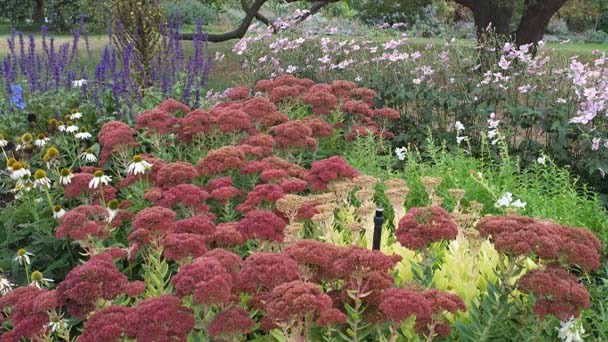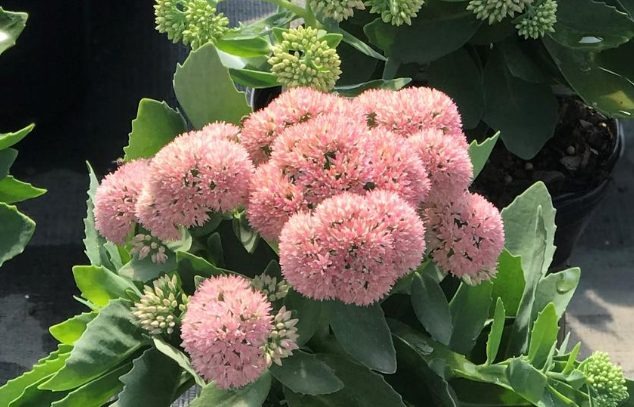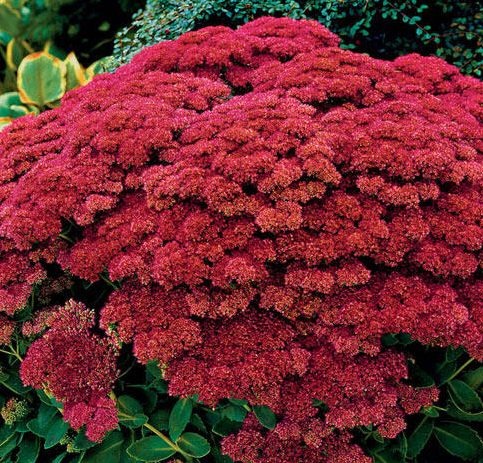Sedum Autumn Fire - Care & Growing Guide 2023
Written by Ivy
Jan 09 2023

Cacti shipped early in the spring might be dormant. These cacti will grow and turn green as the weather warms. Remember, no additional watering should be given until the weather warms up after the initial watering to settle the soil around the roots. When it's rainy and springtime and the plants are dormant, shield them from excess moisture by placing a gallon plastic milk container with the bottom cut out on top of them. In order to prevent an excessive buildup of heat in sunny weather, leave the jug's top off.
Sedum Autumn Overview
| Common Name | Autumn Fire Sedum |
|---|---|
| Botanical Name | Sedum 'Autumn Fire' |
| Zones | 3, 4, 5, 6, 7, 8, 9 |
| Light Requirements | Full Sun |
| Flower Color | Pink |
| Mature Height | 24" tall |
| Mature Spread | 15-18" wide |
| Bloom Time | Late summer to fall |
| Ships As | Potted Plant |
| Soil Type | Low Fertility Soil, Well-Drained Soil |
| Soil Moisture | Average |
| Advantages | Bee Friendly, Attract Butterflies, Attract Birds, Great For Mass Plantings, Extended Bloom Time (more than 4 weeks), Winter Interest, Easy To Grow, Low Maintenance, Good For Containers, Good Rockgarden Or Alpine Plant, Deer Resistant, Rabbit Resistant |
| Planting Time | Spring / Summer, Fall |
When to Plant Sedum Autumn Fire

The best time to plant Autumn Joy stonecrop is in the spring, after the risk of the last frost has passed, for an early summer or late fall growing season. Make sure your sedum plants are established before the late-summer heat wave arrives. Autumn Joy does well in USDA hardiness zones 3 to 10, flourishing in a range of environments. Six hours a day of direct sunlight are also necessary.
Sedum Autumn Fire Care
Size and Growth
‘Autumn Fire' isn't a large plant, rarely growing more than 24″ inches tall and 18" inches wide.
It has herbaceous leaves and grows slowly. The foliage has small, rounded leaves and thick succulent stems, and is frequently a blue-green color.
Flowering and Fragrance
The showy flowers that this late bloomer's plant produces in the late summer are what make it so popular.
Beginning as green buds at the beginning of summer, sedum spectabile 'Autumn Fire' develops clusters of vivid, rosy-pink flowers.
The large rose-colored flower heads open and release their rose-colored blooms.
The flowers' colors gradually shift over the course of the summer. The flowers' transition from a vivid rose color to a dusty, coppery red adds interest for the winter.
Light and Temperature
It is indigenous to parts of Europe and can survive the winter in USDA hardiness zones 3 to 9.
Even in subfreezing temperatures, it can last outside all winter. However, grows best in an environment with full sun to some shade.
When growing something indoors or on a porch, make sure it gets plenty of light throughout the day, but keep it away from windows that receive direct sunlight.
Even through a window, direct sunlight can eventually scorch the leaves.
A room kept at normal room temperature should be sufficient for the plant, but slightly colder temperatures in the winter help promote a fuller bloom.
Watering and Feeding
This plant can withstand droughts. The stems and leaves of autumn fire sedum, a succulent, store water.
Don't overwater the plant by giving it little water too often. As the plant ages, it requires less water.
Although established plants become more drought tolerant, young plants may need more watering during the active growth phase.
When grown outdoors, it only requires additional watering if there isn't enough rainfall.
Give the plant a light watering if you live in an area where the weekly rainfall is less than an inch.
Use general fertilizer once a year. Add the granular pellets to the soil in the spring and cover with 2" inches of mulch.
The plant might not require water during the winter.
Pay attention to the leaves. Watering might be necessary if the leaves start to fall.
Soil and Transplanting
Utilize soil that has been properly drained. If planting outdoors, space the plants at least 18" – 24" inches apart.
Cover the top of the soil with 2" inches of mulch. Mulch aids in moisture conservation and inhibits weed growth.
Clear the mulch from the plant's base after you've added it to make sure it doesn't touch.
Keep the plant from being moved. Sedum autumn fire shouldn't be repotted until the root system has grown too large for the pot or planter box.
Pruning
Although Autumn Joy stonecrop may benefit from tip pruning in the spring to encourage better growth, in most cases, letting the plant thrive on its own will yield an abundance of blooms.
Propagation
Spring cuttings are used to multiply Sedum Autumn Fire. This can be done in the garden by dividing the root mass in the fall or spring. Cutting the fleshy stems in the fall and laying them horizontally in a sunny window is a more intriguing method of propagation. Each leaf node will develop a shoot that can be cut off and rooted in about a month.

Types of Stonecrop
These are some other stonecrop varieties that are closely related to Autumn Joy:
- Hylotelephium 'Autumn Charm': Although the flowers on this plant resemble those of Autumn Joy, the leaves are serrated and have cream edges.
- Hylotelephium spectabile 'Autumn Fire': Compared to Autumn Joy, Autumn Fire blooms for a longer time and has bigger flower heads and stronger stems.
- Sedum 'Mr. Goodbud': If you want flowers that are darker and more purplish, consider this hybrid. A little bit earlier than Autumn Joy, it blooms.
- Sedum spectabile 'Hot Stuff': It only grows 10 to 12 inches tall and has pink and purple flowers, making it a more compact plant than Autumn Joy.
- Sedum spectabile 'Iceberg': Growing to a maximum height of about 16 inches, this plant primarily produces white flowers and is a little smaller than Autumn Joy.
Why Grow Autumn Fire Sedum?
Autumn Fire sedum is prepared to shine while some flowers have passed their prime. This sedum cultivar is renowned for its stunning late-summer and fall color, neat growing habit, and tolerance to drought.
For beginners or gardeners looking to save some time and effort, sedums are incredibly simple plants to grow. After they are established, they require very little maintenance. Like all sedums, Autumn Fire is drought-tolerant and only requires infrequent watering.
Autumn Fire is a tiny bit smaller than some bigger and more rambunctious sedums. Only two feet tall and a little less wide, this sturdy plant can be found. Its size makes it less prone to flopping, which occurs when the stalks sag and leave a gap in the center of the plant.
Overwintering
This plant does not require protection even in regions with severe winters because it is hardy to USDA zone 3. If you decide not to prune it back in the fall, it will die back and reappear the following spring with new foliage and blossoms.
Common Pests and Plant Diseases
Though the fleshy leaves of Autumn Joy stonecrop can be vulnerable to damage from slugs and mealybugs, most common garden pest and disease issues are remarkably absent from it.1 These can be largely controlled by keeping the ground clear of debris, including mulch. If necessary, you can also treat a severe infestation with neem oil. Additionally, occasionally you might see deer munching on the plant's fleshy leaves.
How to Get Autumn Joy to Bloom
Ascertain that your plant is resting in well-drained soil and receiving at least six hours of direct sunlight each day. This plant can actually suffer from very fertile soil because it will want to grow more foliage and stems than flowers. As a result of the shade, your plant won't produce any blooms. Finally, keep in mind that too much moisture in the soil will cause the plant to rot, which means the plant will not produce any beautiful blooms.
Suggested Uses for Sedum Spectabile Autumn Fire
This plant is excellent for garden borders because the vibrant flowers last all summer long. In addition to attracting butterflies and being resistant to deer and rabbits, it benefits pollinators.
It also thrives in containers and grows well on slopes and banks, making it a simple way to add more color to a patio or balcony.
Conclusion
One of the easiest perennials to grow is Sedum Autumn Fire, which should be a staple in every garden. Since it can be grown in most areas of the country, the USDA Hardiness Zones 3 to 9 (find yours here) are suitable for it.
It tolerates arid conditions, high humidity, and poor soil. It also recovers steadily even after a bitterly cold winter. Deer also frequently leave it alone. It eventually reaches a height and width of about two and three feet, respectively.

FAQs
Can Autumn Joy Stonecrop Grow Indoors?
These hardy plants can be grown indoors in containers just fine, but the sunlight and summertime humidity outdoors is where they truly thrive. You should keep in mind that they can endure the winter outdoors in pots because they are hardy enough.
How Long Does Autumn Joy Stonecrop Live?
Expect a six-month growing season that is active. The plant will then die back for the winter and come back in the spring. In the right circumstances, a hardy plant can live for many years.
What Plants Are Similar to Autumn Joy Stonecrop?
Stonecrop resembles both the jade plant and the kalanchoe. Pink Chablis, Purple Emperor, and Carmen are additional excellent choices for the garden.
Latest Updated
- Benefits of Bugleweed - 7 Science-backed Health Benefits
- Bugleweed Dangers & Side Effects - Is It Poisonous?
- How to Plant Evergreen Trees - What You Should Know
- When to Plant Evergreens - Grow Guide for Evergreen Trees
- 12 Wonderful Evergreen Shrubs for Your Garden
- 12 Popular Evergreen Plants with Pictures for Beginners
- When And How To Prune A Lilac Bush Like a Pro
- How to Grow & Care for Lilac Vine (Hardenbergia Violacea)
- Japanese Lilac Tree (Syringa Reticulata) Care & Propagation Guide
- Shumard Oak Pros and Cons - What to Know
Popular Articles
- Winter maintenance of Antirrhinum Majus
- How to Grow Terminalia Mantaly Tree
- How to Grow and Care for Crossostephium Chinense
- How to grow Antirrhinum Majus in spring
- Peristeria Elata (Dove Orchid) Profile: Info & Care Guide
- Underwatered Snake Plant (Sansevieria Trifasciata) - Signs And How To Fix
- How to Care for Brazilian Jasmine Plant (Mandevilla Sanderi)
- How to Grow & Care for Graptopetalum Purple Delight in Summer
- Rosa Chinensis (China Rose): Plant Growing & Care Tips
- How to Care for Baby Sun Rose (Aptenia Cordifolia)